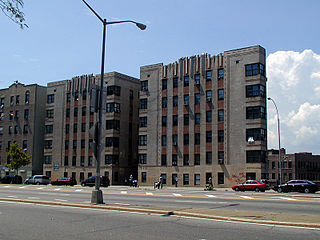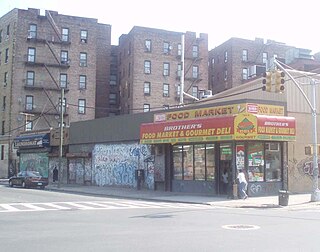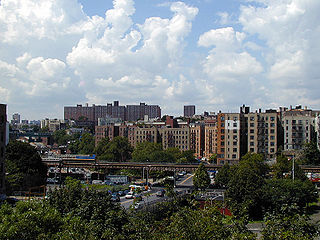Related Research Articles

Gun control, or firearms regulation, is the set of laws or policies that regulate the manufacture, sale, transfer, possession, modification, or use of firearms by civilians.
Sexual assault is an act in which one intentionally sexually touches another person without that person's consent, or coerces or physically forces a person to engage in a sexual act against their will. It is a form of sexual violence, which includes child sexual abuse, groping, rape, or the torture of the person in a sexual manner.
Baychester is a neighborhood geographically located in the northeast part of the Bronx, New York City. Its boundaries are East 222nd Street to the northeast, the New England Thruway (I-95) to the east, Gun Hill Road to the southwest, and Boston Road to the northwest. Eastchester Road is the primary thoroughfare through Baychester.
Pelham Gardens is a neighborhood located in the Northeast section of the Bronx, New York City. Its boundaries, starting from the north and moving clockwise are East Gun Hill Road to the north and east, Pelham Parkway to the south, and the IRT Dyre Avenue Line to the west ending at the esplanade. Eastchester Road is the primary thoroughfare through Pelham Gardens.

East New York is a residential neighborhood in the eastern section of the borough of Brooklyn in New York City, United States. Its boundaries, starting from the north and moving clockwise, are roughly the Cemetery Belt and the Queens borough line to the north; the Queens borough line to the east; Jamaica Bay to the south, and the Bay Ridge Branch railroad tracks and Van Sinderen Avenue to the west. Linden Boulevard, Pennsylvania Avenue, and Atlantic Avenue are the primary thoroughfares through East New York.

Tremont is a residential neighborhood in the West Bronx, New York City. Its boundaries are East 181st Street to the north, Third Avenue to the east, the Cross-Bronx Expressway to the south, and the Grand Concourse to the west. East Tremont Avenue is the primary thoroughfare through Tremont.

Williamsbridge is a neighborhood geographically located in the north-central portion of the Bronx in New York City. Its boundaries, starting from the north and moving clockwise are East 222nd Street to the north, Boston Road to the east, East Gun Hill Road to the south, and the Bronx River to the west. White Plains Road is the primary thoroughfare through Williamsbridge.

East Tremont is a residential neighborhood located in the West Bronx, New York City. From the north and moving clockwise, it is bounded by East 180th Street, Southern Boulevard, the Cross-Bronx Expressway and Third Avenue. East Tremont Avenue is the primary thoroughfare through the neighborhood.

Morris Heights is a residential neighborhood located in the West Bronx. Its boundaries, starting from the north and moving clockwise are: West Burnside Avenue to the north, Jerome Avenue to the east, the Cross-Bronx Expressway to the south, and the Harlem River to the west. University Avenue is the primary thoroughfare through Morris Heights.

West Farms is a residential neighborhood in The Bronx, New York City. Its boundaries, are: Bronx Park to the north, the Bronx River Parkway to the east, the Cross-Bronx Expressway to the south, and Southern Boulevard to the west. East Tremont Avenue is the primary thoroughfare through West Farms.

Castle Hill is a neighborhood located in the southeast section of the borough of the Bronx in New York City. Its boundaries are Waterbury Avenue and Westchester Avenue to the north, Westchester Creek to the east, the East River to the south, and White Plains Road to the west. Unionport is a subsection of Castle Hill, typically considered north of Lafayette Avenue.

Gun violence in the United States results in tens of thousands of deaths and injuries annually, and was the leading cause of death for children 19 and younger in 2020. In 2018, the most recent year for which data are available as of 2021, the Centers for Disease Control and Prevention's (CDC) National Center for Health Statistics reports 38,390 deaths by firearm, of which 24,432 were by suicide. The rate of firearm deaths per 100,000 people rose from 10.3 per 100,000 in 1999 to 12 per 100,000 in 2017, with 109 people dying per day or about 14,542 homicides in total, being 11.9 per 100,000 in 2018. In 2010, there were 19,392 firearm-related suicides, and 11,078 firearm-related homicides in the U.S. In 2010, 358 murders were reported involving a rifle while 6,009 were reported involving a handgun; another 1,939 were reported with an unspecified type of firearm. In 2011, a total of 478,400 fatal and nonfatal violent crimes were committed with a firearm. Gun crimes are covered by 18 USC 922 and 18 USC 924, which are the principal federal firearm statutes.

Gun-related violence is violence committed with the use of a firearm. Gun-related violence may or may not be considered criminal. Criminal violence includes homicide, assault with a deadly weapon, and suicide, or attempted suicide, depending on jurisdiction. Non-criminal violence includes accidental or unintentional injury and death. Also generally included in gun violence statistics are military or para-military activities.
In Chicago, crime has been tracked by the Chicago Police Department's Bureau of Records since the beginning of the 20th century. The city's overall crime rate, especially the violent crime rate, is higher than the US average. Chicago was responsible for nearly half of 2016's increase in homicides in the US, though the nation's crime rates remained near historic lows as of 2016. Some attribute the city's strong gang culture to the city's unusually high crime rate compared to neighboring cities, and some do not.

Defensive gun use (DGU) is the use or presentation of a firearm for self-defense, defense of others or, in some cases, protecting property. The frequency of incidents involving DGU, and their effectiveness in providing safety and reducing crime is a controversial issue in gun politics and criminology, chiefly in the United States. Different authors and studies employ different criteria for what constitutes a defensive gun use which leads to controversy in comparing statistical results. Perceptions of defensive gun use are recurring themes in discussions over gun rights, gun control, armed police, open and concealed carry of firearms.

The Public Safety and Recreational Firearms Use Protection Act, popularly known as the Federal Assault Weapons Ban (AWB), was a subsection of the Violent Crime Control and Law Enforcement Act of 1994, a United States federal law which included a prohibition on the manufacture for civilian use of certain semi-automatic firearms that were defined as assault weapons as well as certain ammunition magazines that were defined as large capacity.
Anthony Allan Braga is an American criminologist and the Jerry Lee Professor of Criminology at the University of Pennsylvania. Braga is also the Director of the Crime and Justice Policy Lab at the University of Pennsylvania. He previously held faculty and senior research positions at Harvard University, Northeastern University, Rutgers University, and the University of California at Berkeley. Braga is a member of the federal monitor team overseeing the reforms to New York City Police Department (NYPD) policies, training, supervision, auditing, and handling of complaints and discipline regarding stops and frisks and trespass enforcement.
Douglas James Wiebe is associate professor of epidemiology at the Center for Clinical Epidemiology and Biostatistics in the Perelman School of Medicine at the University of Pennsylvania.

Mass shootings are incidents involving multiple victims of firearm-related violence. Definitions vary, with no single, broadly accepted definition. One definition is an act of public firearm violence—excluding gang killings, domestic violence, or terrorist acts sponsored by an organization—in which a shooter kills at least four victims. Using this definition, one study found that nearly one-third of the world's public mass shootings between 1966 and 2012 occurred in the United States, The New York Times recorded the same total of mass shootings for that span of years. Using a similar definition, The Washington Post recorded 163 mass shootings in the United States between 1967 and June 2019. Mother Jones recorded 140 mass shootings between 1982 and February 2023. The Associated Press recorded 59 mass shootings between 2006 and August 2022. The Violence Project of the National Institute of Justice recorded 185 mass shootings from 1966 to December 2022. The Federal Bureau of Investigation designated 61 events as active shooter incidents in 2021.
The Danzig Street shooting, or Danzig shooting, was a gang-related shooting that occurred on the evening of 16 July 2012 at a block party on Danzig Street in the West Hill neighbourhood of Toronto, Canada. Rival gang members Folorunso Owusu, 17, and Nahom Tsegazab, 19, along with an unidentified third gunman, opened fire in a crowd of two hundred people. This resulted in the deaths of Joshua Yasay and Shyanne Charles, and the injury of twenty-four others, making it the worst mass shooting in Toronto.
References
- ↑ Fried, Linda P. (2016-11-21). "Announcement that Branas will join Mailman School of Public Health". Mailman School of Public Health. Columbia University.
- ↑ "Charles Branas Takes Aim at Gun Violence". Public Health Now. Mailman School of Public Health. 2016-11-22.
- ↑ Branas, Charles C.; Richmond, Therese S.; Culhane, Dennis P.; Ten Have, Thomas R.; Wiebe, Douglas J. (November 2009). "Investigating the Link Between Gun Possession and Gun Assault". American Journal of Public Health. 99 (11): 2034–2040. doi:10.2105/AJPH.2008.143099. PMC 2759797 . PMID 19762675 . Retrieved 2009-10-06.
- ↑ Hamblin, James (2012-12-14). "Our Unhealthy Fear of Vacant Land". The Atlantic.
- ↑ Weichselbaum, Simone (2015-12-09). "Could Trees Help Stop Crime?". The Marshall Project.
- ↑ Diep, Francie (2016-10-14). "Why Cleaning Up Abandoned Lots Can Reduce Shootings". Pacific Standard.
- ↑ Dengler, Roni (2018-02-18). "This city fights crime with gardening". Science.
- ↑ Jerrett, Michael (2018-07-20). "Nature Exposure Gets a Boost From a Cluster Randomized Trial on the Mental Health Benefits of Greening Vacant Lots". JAMA.
- ↑ Branas, Charles; et al. (2018-02-26). "Citywide cluster randomized trial to restore blighted vacant land and its effects on violence, crime, and fear". Proceedings of the National Academy of Sciences of the United States of America. 115 (12): 2946–2951. doi: 10.1073/pnas.1718503115 . PMC 5866574 . PMID 29483246.